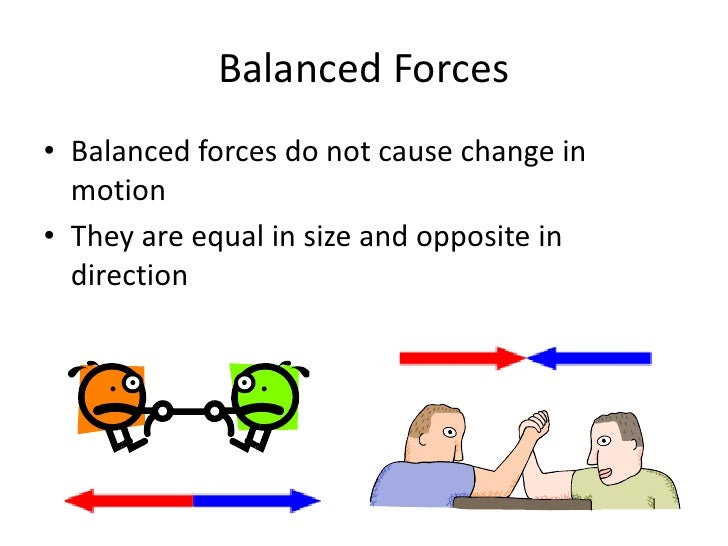forces in different directions when the forces on an object produce a net force of 0 n, the forces are balanced.
For example, when we push a table from both sides with equal force, the table stays where it is. Inertia is the resistance of any physical object to any change in its state of motion, including changes to its speed and direction. An example of a balanced laminate is 0°, +45°, −45°, 90°, −45°, +45°, 0°, whereas an unbalanced laminate would be 0°, +45°, −45°, 90°, −45°, +45°, 90°. In both cases, a new substance is formed. Newton (n) is the si unit of force.

Newton (n) is the si unit of force.
forces are described as pushes and pulls and examples are given. Is equal to the largest force iii. In this setup and object of their choice moves the farthest with the least amount of force. unbalanced forces an unbalanced force always causes a change in motion when unbalanced forces act in opposite directions you can find the net force net force is the overall force acting on an object. There are two ways to represent a force balanced and unbalanced forces: Imbalanced data is not always a bad thing, and in real data sets, there is always some degree of imbalance. Resultant forces and how to calcul When one force is stronger than the other the result is motion. forces cause an object to change its speed, direction, or both. unbalanced forces acting on an object will cause it to accelerate, or change its motion, in the direction of the applied force. Is force that a person or thing applies to another object. Buoyant force is stronger than gravity. This is an example of chemical change.
forces should be drawn in pairs and the size of the arrow shows the size of the force. The force makes an object to change its position, direction or speed. Name date class forces key concept how do balanced and unbalanced forces differ? forces are described as pushes and pulls and examples are given. Chemical reactions and equations g10.

Gravity is acting on it c.
Acceleration forces have both magnitude and direction components forces a force causes an object to move, accelerate, change speed, or direction forces are represented by: This science lesson is appropriate for students in 6th, 7th, and 8th grades, and it takes approximately 30 minutes of class time to complete. An unbalanced force is acting on it ii. Calculating net force with newtons. Resultant forces and how to calcul This is an example of chemical change. The ppt provides guidance for the entire lesson including activating, teaching and summarizing strategies. balanced and unbalanced forces newton's first law of motion assumes that the forces acting on the object are balanced. It acts in a downward direction—toward the center of the earth. When two equal forces act in opposite directions the result is that the forces are balanced and there is no motion. For example, when we push a table from both sides with equal force, the table stays where it is. balanced and unbalanced forces lesson nine: These forces can act in different directions and with different magnitudes.
Lift is created by differences in air pressure. balanced and unbalanced forces when the net force on an object is not 0 n, the forces on the object are unbalanced. In this lesson students learn the definition of "force." It is measured as meters traveled per second per second, or meters per second squared (m/s 2). Name date class forces key concept how do balanced and unbalanced forces differ?

Gravity is acting on it c.
When forces are balanced, the total force Resultant forces and how to calcul Gravity is stronger than buoyant force. Humans are surrounded by examples of chemical reactions. forces in different directions when the forces on an object produce a net force of 0 n, the forces are balanced. A fluid can be a gas or a liquid. There are balanced and unbalanced forces: What type of changes can be produced by balanced forces? When one force is stronger than the other the result is motion. forces are described as pushes and pulls and examples are given. Some of the worksheets below are force and motion worksheets in pdf, lessons on force and motion, balanced and unbalanced forces and velocity and acceleration with colorful diagrams. There are two ways to represent a force balanced and unbalanced forces: If the object is solid.
32+ Balanced And Unbalanced Force Definition Class 8 Background. It acts in a downward direction—toward the center of the earth. Examples of forces are gravity, friction, magnetism, and applied forces. The tendency to resist a change in an object's motion is a. This science lesson is appropriate for students in 6th, 7th, and 8th grades, and it takes approximately 30 minutes of class time to complete. If the two forces produce motion in the body, the forces are said to be unbalanced.






